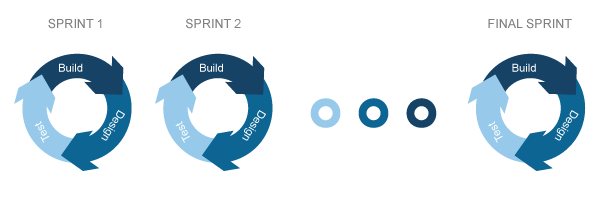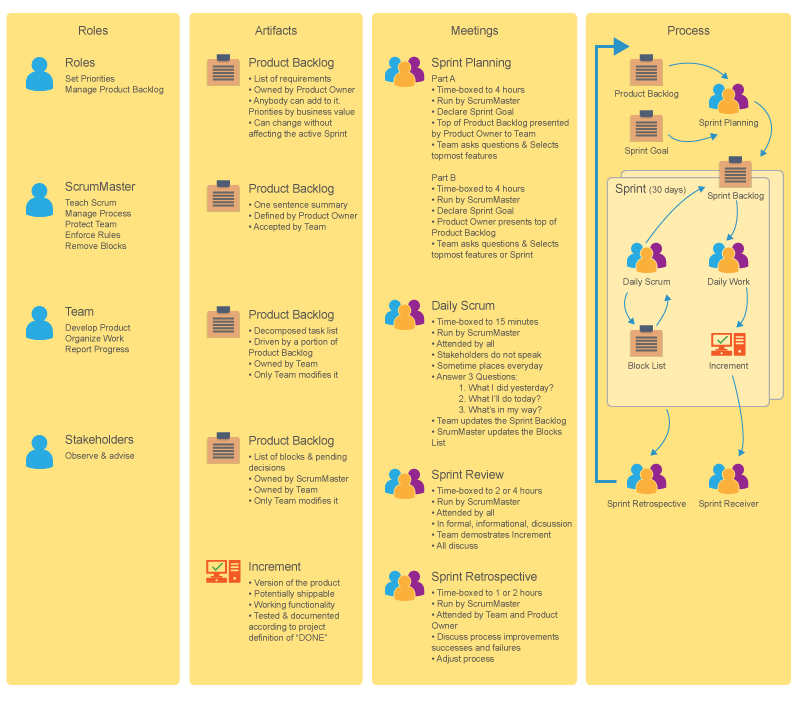Introduction to Agile Software Development
Agile Software Development is a dynamic approach to creating software that thrives in environments of uncertainty and change. Unlike traditional methodologies, which rely on rigid plans and extensive documentation, Agile emphasizes flexibility, collaboration, and delivering functional software incrementally. This guide explores Agile’s principles, methodologies, history, and practical applications, enriched with examples to help teams implement it effectively.

Agile is designed to deliver high-quality software that meets user needs quickly and cost-effectively. It achieves this through iterative cycles, frequent feedback, and adaptive planning, ensuring that evolving requirements are embraced rather than resisted.
What is Agile Software Development?
Agile Software Development is an umbrella term for methodologies and practices rooted in the Agile Manifesto, a set of values and principles established in 2001 by 17 software developers. Agile prioritizes delivering small, functional increments of software frequently, allowing teams to adapt to changing requirements and user feedback. This approach contrasts with traditional “waterfall” methods, where projects follow a linear path with fixed scope, often leading to delays and misaligned deliverables.
Key Characteristics of Agile
-
Iterative Development: Deliver partial solutions (e.g., features or prototypes) in short cycles called sprints, typically lasting 1–4 weeks.
-
Frequent Delivery: Release working software regularly to gather feedback and refine the product.
-
Customer-Centric: Prioritize user satisfaction through continuous collaboration and responsiveness to change.
-
Team Empowerment: Foster self-organizing, cross-functional teams to drive innovation and efficiency.
Example: A startup building a mobile app uses Agile to release a basic version with core features (e.g., user login and profile creation) within two weeks. User feedback reveals a need for a search function, which the team prioritizes in the next sprint, ensuring the app evolves with user needs.
The Agile Manifesto
The Agile Manifesto, published in 2001, is the cornerstone of Agile Software Development. It outlines four core values and twelve principles that guide Agile practices.
Core Values of the Agile Manifesto

The Manifesto emphasizes:
-
Individuals and interactions over processes and tools.
-
Working software over comprehensive documentation.
-
Customer collaboration over contract negotiation.
-
Responding to change over following a plan.
These values prioritize human collaboration, functional deliverables, and adaptability. For instance, while documentation is valuable, a working prototype that users can test is prioritized to ensure alignment with their needs.
Example: A development team working on an e-commerce platform focuses on delivering a functional checkout system over creating detailed technical documentation. They collaborate with the client weekly to refine features based on real-world testing.
Twelve Principles of Agile

The Agile Manifesto’s principles provide a framework for implementing its values:
-
Customer satisfaction through early and continuous delivery of valuable software.
-
Welcome changing requirements, even late in development, to ensure competitive advantage.
-
Deliver working software frequently, from a couple of weeks to a couple of months.
-
Daily collaboration between business stakeholders and developers.
-
Build projects around motivated individuals, providing them with support and trust.
-
Prioritize face-to-face communication for efficient information sharing.
-
Working software is the primary measure of progress.
-
Promote sustainable development with a consistent pace for sponsors, developers, and users.
-
Continuous attention to technical excellence and good design.
-
Simplicity—maximizing the work not done—is essential.
-
Self-organizing teams produce the best architectures, requirements, and designs.
-
Regular reflection and adjustment to improve team effectiveness.
Example: A team developing a healthcare app adheres to these principles by delivering a patient scheduling feature in a two-week sprint. They meet daily with hospital staff to refine requirements and adjust the design based on feedback, ensuring the feature is both functional and user-friendly.
The History of Agile
Agile’s roots trace back to the 1950s with iterative approaches like Test-Driven Development in Project Mercury. However, it gained momentum in the 1990s with methodologies such as:
-
1991: James Martin’s Rapid Application Development (RAD) emphasized quick prototyping.
-
1995: Scrum was introduced at OOPSLA, formalizing iterative development.
-
1995: Dynamic Systems Development Method (DSDM) provided a structured Agile framework.
-
1996: Extreme Programming (XP) emerged, focusing on engineering practices like pair programming.
-
1999: Feature-Driven Development (FDD) was described, emphasizing feature delivery.
-
2001: The Agile Manifesto was published, unifying these lightweight methodologies.
-
2003: Lean Software Development introduced principles from lean manufacturing.
The 2001 Agile Manifesto was a pivotal moment, consolidating these approaches into a cohesive philosophy that revolutionized software development.
Example: A software company in the 1990s using RAD might have built a prototype for a payroll system in weeks, testing it with users before committing to a full-scale implementation, a precursor to modern Agile practices.
Agile vs. Traditional Development
Traditional development, often called the waterfall model, fixes the project scope while allowing cost and schedule to vary. This approach assumes requirements are fully specifiable upfront, which often leads to inflexibility when changes arise. Adding resources to a delayed waterfall project can exacerbate issues, as noted in Brooks’ Law: “Adding manpower to a late software project makes it later.”
Agile inverts this model by fixing cost and schedule while allowing scope to vary. This enables teams to deliver high-priority features first and adapt to changes without derailing the project.
Comparison Table
|
Aspect |
Traditional (Waterfall) |
Agile |
|---|---|---|
|
Scope |
Fixed |
Variable |
|
Cost & Schedule |
Variable |
Fixed |
|
Planning |
Extensive upfront planning |
Adaptive, iterative planning |
|
Delivery |
Single delivery at project end |
Frequent, incremental deliveries |
|
Change Management |
Resistant to changes |
Embraces changes |
|
Team Structure |
Hierarchical, role-specific |
Self-organizing, cross-functional |
Example: In a waterfall project, a team might spend six months defining requirements for a CRM system, only to find that market needs shifted during development. In Agile, the team delivers a basic CRM in one-month sprints, incorporating new requirements like mobile access based on client feedback.
Scrum: A Leading Agile Framework
Scrum is the most widely used Agile framework, often mistaken for Agile itself. While Agile is a philosophy, Scrum is a specific methodology that implements Agile principles through structured roles, events, and artifacts.

How Scrum Works
Scrum organizes work into sprints, time-boxed iterations (typically 2–4 weeks) that deliver a working product increment. Key components include:
1. Product Backlog
The product backlog is a prioritized list of features, bugs, technical tasks, and knowledge acquisition items. The Product Owner collaborates with stakeholders to define and prioritize these items.
Example: For a fitness app, the product backlog might include:
-
Feature: Track workout history.
-
Bug: Fix incorrect calorie calculations.
-
Technical Work: Optimize database queries.
-
Knowledge Acquisition: Research wearable device integration.
2. Sprint Planning
Each sprint begins with a planning meeting where the team selects backlog items to complete. The Product Owner defines “what” to build, while the team determines “how.” A sprint backlog is created, detailing tasks and effort.
Example: A team plans a two-week sprint to deliver a workout tracking feature. They break it into tasks like designing the UI, coding the backend, and testing the feature, estimating effort to ensure completion within the sprint.
3. Daily Scrum
A 15-minute daily meeting where team members report:
-
What they did yesterday.
-
What they’ll do today.
-
Any blockers impeding progress.
Example: A developer reports completing the workout logging UI, plans to integrate it with the backend today, and flags a database issue as a blocker, which the Scrum Master addresses.
4. Sprint Review
At the sprint’s end, the team demonstrates the working increment to stakeholders, gathering feedback to refine the product backlog.
Example: The fitness app team showcases the workout tracking feature to gym owners, who suggest adding a goal-setting option, which is added to the backlog for the next sprint.
5. Sprint Retrospective
The team reflects on the sprint, discussing what went well, what didn’t, and how to improve. This fosters continuous improvement.
Example: The team notes that unclear requirements slowed development. They agree to hold a pre-sprint refinement session to clarify future backlog items.
Scrum Roles
-
Product Owner: Manages the product backlog, prioritizes features, and ensures alignment with stakeholder goals.
-
Scrum Master: Facilitates Scrum processes, removes impediments, and promotes team self-organization.
-
Development Team: Cross-functional, self-organizing group responsible for delivering the product increment.
Example: In a project to build an online learning platform, the Product Owner prioritizes a quiz feature, the Scrum Master resolves a tool licensing issue, and the Development Team (including developers, testers, and designers) builds and tests the feature.
Scrum Artifacts
-
Product Backlog: The master list of work items.
-
Sprint Backlog: Tasks committed to for the current sprint.
-
Increment: The working product delivered at the sprint’s end.
Example: The sprint backlog for a payment gateway project includes tasks like “Implement Stripe API” and “Test payment validation,” resulting in a functional payment module as the increment.
Benefits of Agile and Scrum
-
Faster Delivery: Frequent releases allow early user feedback and quicker market entry.
-
Flexibility: Adapting to changes ensures the product remains relevant.
-
Improved Quality: Continuous testing and feedback enhance software reliability.
-
Team Empowerment: Self-organizing teams foster innovation and accountability.
-
Customer Satisfaction: Close collaboration ensures the product meets user needs.
Example: A team building a travel booking app uses Scrum to deliver a flight search feature in two weeks. User feedback highlights a need for hotel bookings, which the team prioritizes, ensuring the app aligns with market demands.
Tools for Agile Development
Agile teams benefit from tools that streamline backlog management, sprint planning, and collaboration. Popular options include:
-
Visual Paradigm: Offers user story mapping, affinity estimation, and sprint management.
-
Jira: Tracks tasks and sprints with robust reporting.
-
Trello: Simplifies backlog management with visual boards.
-
Azure DevOps: Integrates Agile planning with CI/CD pipelines.
Example: A team uses Visual Paradigm to create a user story map for a retail app, grouping features like “product browsing” and “cart management” into sprints, ensuring clear prioritization.
Getting Started with Agile
-
Define the Vision: Conduct discovery sessions with stakeholders to understand goals, challenges, and user needs.
-
Build the Product Backlog: Create a prioritized list of features and tasks, refined with stakeholder input.
-
Plan the First Sprint: Select high-priority backlog items and define tasks for a 1–4 week sprint.
-
Iterate and Improve: Deliver increments, gather feedback, and refine processes through retrospectives.
-
Use Agile Tools: Leverage software like Visual Paradigm or Jira to manage workflows efficiently.
Example: A startup launching a food delivery app holds a vision session with restaurant owners, identifying key features like order tracking and payment integration. They prioritize order tracking for the first sprint, delivering a functional prototype in two weeks.
Challenges and Solutions
-
Challenge: Unclear requirements can delay sprints.
-
Solution: Conduct backlog refinement sessions to clarify user stories.
-
-
Challenge: Resistance to change from stakeholders accustomed to waterfall.
-
Solution: Educate stakeholders on Agile benefits and involve them in reviews.
-
-
Challenge: Overloaded sprints due to overcommitment.
-
Solution: Use velocity tracking to set realistic sprint goals.
-
Example: A team overcommits to delivering multiple features in a sprint, causing delays. They analyze their velocity (e.g., 20 story points per sprint) and limit future sprints to match this capacity, improving delivery reliability.
Conclusion
Agile Software Development, with frameworks like Scrum, empowers teams to deliver high-quality software in dynamic environments. By prioritizing collaboration, adaptability, and frequent delivery, Agile ensures products meet user needs efficiently. Whether you’re a startup or an enterprise, adopting Agile can transform your development process, fostering innovation and customer satisfaction.
Ready to embrace Agile? Start with a clear vision, build a prioritized backlog, and leverage tools like Visual Paradigm to streamline your journey. With continuous reflection and adaptation, your team can achieve sustainable success in software development.